|
The Internet is a powerful resource. It provides us instant
access to information, and brings us together via email,
bulletin boards, chat rooms, and instant messaging. FAOL
is a wonderful example of the Internet at its best. The Internet,
however, will never replace the printed page.
I've loved books and fishing since my youngest years, although
I did not start fly fishing until 1993. This column will give
me an opportunity to share reviews of some of my favorite fly
fishing and tying books (and some that are not such favorites)
with my friends here at FAOL. My library reflects my tastes
and interests, and so will this column. It will be heavily
slanted towards cold water fishing and tying for trout and
steelhead, and won't touch much on areas of which I know little,
such as warm or salt water fishing.
I hope that these reviews will motivate some of you to pick up
a good book, on this or any subject, and read.
~ Stu Farnham
Two By The Stream Doctor
In this week's column I'll review a couple of books
by Colbert Cushing, aka "Cush" or "Bert", aka the
Streamdoctor here on FAOL. Cushing is a retired stream
biologist from Colorado State University and an avid
fly angler. These two books represent those two
intersecting aspects of Cush's life.
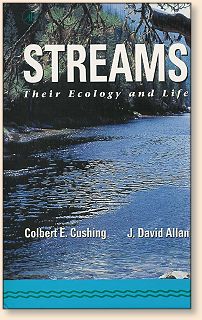 Streams: Their Ecology and Life
Streams: Their Ecology and Life
by Colbert E. Cushing & J. David Allan
Paperback: 366 pages
Publisher: Academic Press; 1st edition (September 2001)
ISBN: 0120503409
Fly fishers spend an inordinate time thinking
about the fish they pursue, the food they are
tying to imitate and the gear and techniques
they use to pursue their quarry. Very little
thought is given to ecosystem in which they
pursue their prey: the stream. In Streams,
Cushing and his colleague J. David Allan (from
the University of Michigan) provide a comprehensive
look at the ecology of moving water.
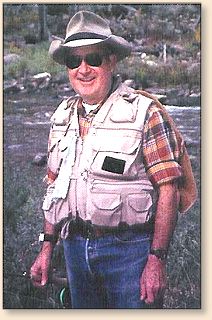
The first few chapters explore the basic physical
realities of streams: the cycle by which water goes
between its liquid, earthbound form, into the
atmosphere by evaporation, and back to earth as
precipitation. The nature of streambeds and the
seasonal effects of runoff and drought are explored.
The other inorganic physical factors of light, geology,
chemistry, and temperature are discussed.
Life is, fundamentally, about the exchange of energy
in the form of food. Cushing and Allan describe the
complex feeding relationships in a stream in terms
of food webs, including prey and predator, and food
sources ranging from dissolved organic matter to in
stream and terrestrial foods.
Following the first five chapters, which establish context
and conceptual background, we get to the heart of the
matter: trout streams. The general characteristics of
trout habitat are discussed, and specific example from
the East (Beaverkill), Midwest (AuSable), and West
(Madison) are presented. The many environmental
challenges facing our trout habitat are discussed:
mining, logging, grazing, and the impacts of urban
development and drought are presented, as well as
potential solutions to these problems.
Anyone living in the Pacific Northwest sees the dramatic
differences in productivity between the swift flowing
freestone streams of the Pacific slope, and the rich
tail waters east of the coastal mountains. Cush provides
us with the scientific underpinnings of these differences
in a discussion of biomass.
The bulk of the remainder of the book walks up the food
chain, from algae and plants through insects, crustaceans,
and other invertebrate life forms. We then get to the heart
of the matter: fish. Not all of the families presented
are of direct interest to the fly fisher, except to the
extent that they inhabit the streams and rivers we love.
Chapters on land-born life forms (amphibians, reptile,
birds, and mammals) the live around flowing water round
out this part of the book.
The most important chapter comes right before the
extensive bibliography. Humans are deer trapped on
the island earth, and like a herd of deer on an island
we are rapidly using up the resources that sustain both
body and soul. Cush and Dr. Allan detail the threats
faced by rivers, both in North America and around the
world. They provide a call to action for those of us
who love the outdoors, and a blueprint for riparian
protection and restoration.
This book is a valuable resource to the fully informed
fly fisher and lover of the outdoors. Along with our
love of sport comes the responsibility of stewardship.
Effective stewardship must be based in understanding.
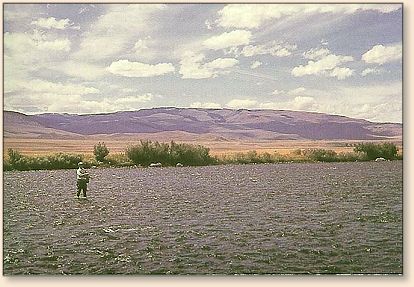
There's a class of books for which I have a fondness
that goes beyond the quality of their writing or the
events and facts they describe. For example, my good
friend Ron Johnstad is a retired Lutheran minister
who, with his wife Mary Ellen, runs a bed and breakfast
in Montana's Paradise Valley, Ron has written a memoir
of his life outdoors under the Big Sky. His book is
not great literature, great sporting literature, or
even very good writing. But I cherish it because Ron
shines so clearly on every page.
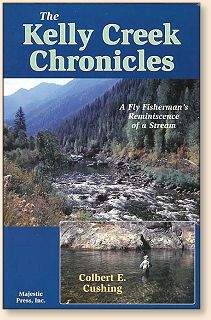 The Kelly Creek Chronicles
The Kelly Creek Chronicles
by Colbert E. Cushing
Paperback: 96 pages
Publisher: Majestic Press; (September 15, 2002)
ISBN: 0962531170
The second book reviewed in this column belongs
to that same family. It is Colbert Cushing's memoir
of 18 years fishing Idaho's Kelly Creek.
Along with the Lochsa, Selway, and St. Joe Rivers,
Kelly Creek is at the heart of the Gem State's
wonderful wild cutthroat trout country. These
streams run crystal clear, deep, and cold, and
full of beautiful, willing wild and native trout.
The book details the minutia of successive summers
fishing Kelly Creek with friends. We get to know
Cush and his friends, including Don Watson, Bill
Rickard, and others as they fish the Bridge Pool,
the Rock Pool, Tree Pool, and Rickard's and Cushing's
Pools.
The stories in this memoir will be familiar to anyone
who has spent their time away from work and home chasing
trout in the woods and mountains of the northwest.
There's a comfort in that familiarity, as well as a
resonance with the trips we've each taken, and the
friends with whom we have taken them. ~ Stu Farnham
About Stu
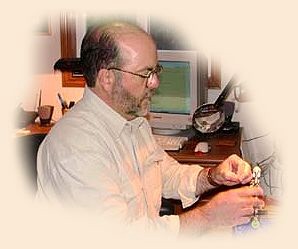 Stu Farnham is a New Englander by birth, who was transplanted to
and put down roots in Oregon in the early 1990s, now residing in
the Seattle area. A software engineering manager by vocation,
he can be found in his spare time chasing trout and steelhead
in the rivers of the Pacific Northwest, chasing his four Gordon
Setters (who in turn are chasing chukar), tying flies, reading,
or working on his website. Colleen, his long suffering wife of
28 years, is a professionally trained personal chef.
Stu Farnham is a New Englander by birth, who was transplanted to
and put down roots in Oregon in the early 1990s, now residing in
the Seattle area. A software engineering manager by vocation,
he can be found in his spare time chasing trout and steelhead
in the rivers of the Pacific Northwest, chasing his four Gordon
Setters (who in turn are chasing chukar), tying flies, reading,
or working on his website. Colleen, his long suffering wife of
28 years, is a professionally trained personal chef.
|
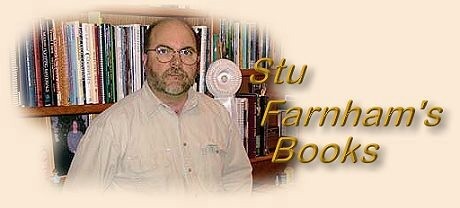

 Stu Farnham is a New Englander by birth, who was transplanted to
and put down roots in Oregon in the early 1990s, now residing in
the Seattle area. A software engineering manager by vocation,
he can be found in his spare time chasing trout and steelhead
in the rivers of the Pacific Northwest, chasing his four Gordon
Setters (who in turn are chasing chukar), tying flies, reading,
or working on his website. Colleen, his long suffering wife of
28 years, is a professionally trained personal chef.
Stu Farnham is a New Englander by birth, who was transplanted to
and put down roots in Oregon in the early 1990s, now residing in
the Seattle area. A software engineering manager by vocation,
he can be found in his spare time chasing trout and steelhead
in the rivers of the Pacific Northwest, chasing his four Gordon
Setters (who in turn are chasing chukar), tying flies, reading,
or working on his website. Colleen, his long suffering wife of
28 years, is a professionally trained personal chef.
 Streams: Their Ecology and Life
Streams: Their Ecology and Life
 The Kelly Creek Chronicles
The Kelly Creek Chronicles